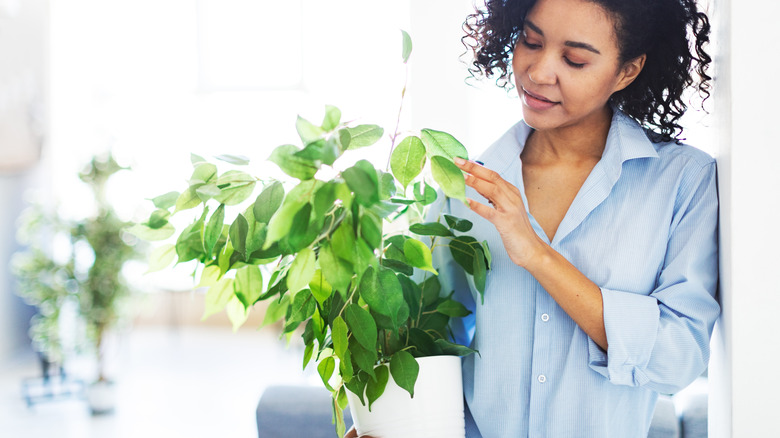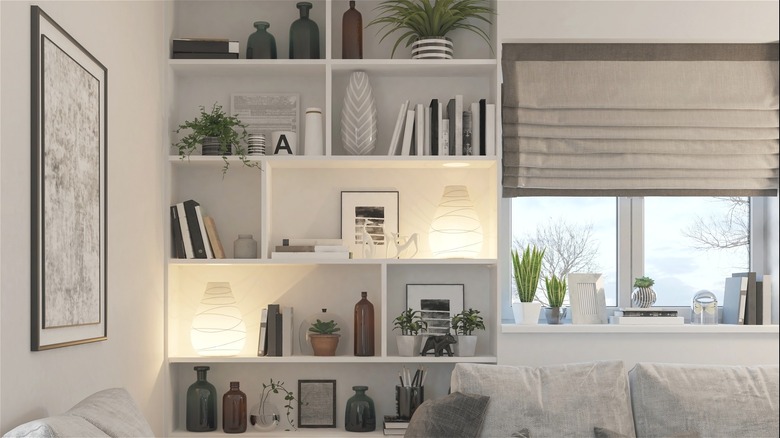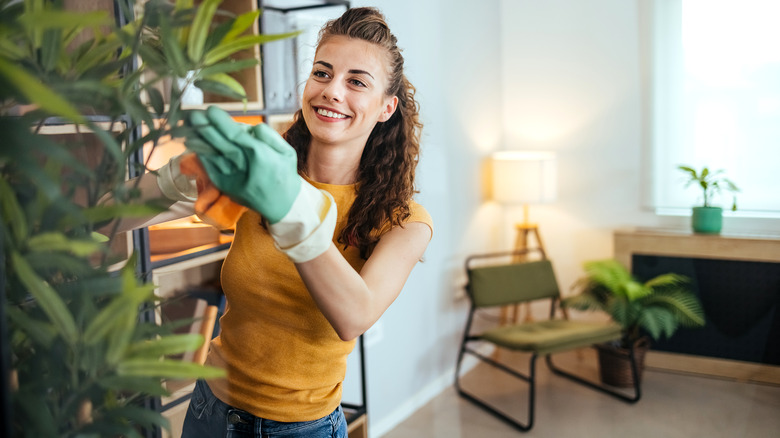Where To Put Fake Plants To Make Them Worth Their While
Adding a plant to every room is a brilliant way to make your home come alive — even if you don't use living plants. While real plants may provide more tangible health benefits, having fake types in your home can still be better than having no greenery at all. In fact, artificial plants (and even pictures of greenery) still boost your mood and reduce anxiety. Plus, they're allergy-free, mess-free, and stress-free. When comparing fake and real plants, maintaining artificial types is often easier than caring for living ones, but knowing how to style faux ones in your home presents its own challenges.
The best way to decorate with artificial plants is to put them in out-of-reach places where live types wouldn't thrive. Some good examples could be on the upper shelves of your bookshelf or in a dimly-lit bathroom. Keeping artificial greenery in your home is a great way to liven up the space, but no one wants their plants to seem obviously fake. Learn more about where and how to style fake types in your home and some do's and don'ts of faux plant care.
Fake plants are perfect for low-traffic areas
The best locations for your faux plants boil down to two things: logistics and aesthetics. Where would a live plant not survive well? Dark rooms, bathrooms, and basements make sense logistically for fake types. For example, artificial greenery can exist on a tall bookshelf without needing any sunlight, soil, or water. On the other hand, if you were to put a live plant there, weekly maintenance could easily become a chore. However, you want your room to have at least some semblance of natural light so the fake plants seem convincing, as no plant stays that green in a windowless bathroom. You may also want to put faux types in areas you'd prefer to keep clean and tidy like your bedside table, a child's room, or anywhere they could be knocked over by pets or kids.
Aesthetics are the other factor to consider. Where can you put this plant so it doesn't seem obviously fake? Again, hard-to-reach areas like bookshelves and corners are ideal locations. Placing them up and away will help to disguise their plastic sheen, and you'll be able to enjoy the greenery without worrying about maintenance. On the other hand, setting a fake plant on the windowsill can make it seem more real. Avoid having fake types in an interactive location like on the coffee table, in the front entryway, or on the kitchen bar, as this makes it easy for guests to determine that they're plastic.
Dos and don'ts for fabulous faux plants
The best thing you can do to take care of your faux plants starts before you even bring them home: invest in high-quality pieces. Super plastic-y plants are much harder to style, and their monochrome leaves are a dead giveaway. Instead, look for artificial greenery with color variation in the leaves, flexible stems, and a thin, rubber texture. Transferring the plant to a larger, sturdier pot and bending the leaves and stems to look more asymmetrical can make it seem even more realistic. You could also consider adding real soil or moss to the pot. For totally windowless rooms, opt for faux flowers or greenery cuts in a vase of water. Given the dim lighting conditions, this will make more sense than a potted type.
Don't let dust collect on the leaves, as this can make them look dull and lifeless. Be sure to clean them every time you dust your furniture. Finally, don't rely too heavily on fake plants to decorate your home; having a mix of live and fake plants seems more convincing and will keep your houseguests on their toes. Plus, live greenery supports good air quality and could up your feng shui game. Species like snake plants, pothos, and peace lilies are nearly impossible to kill, even for the most neglectful owners.


